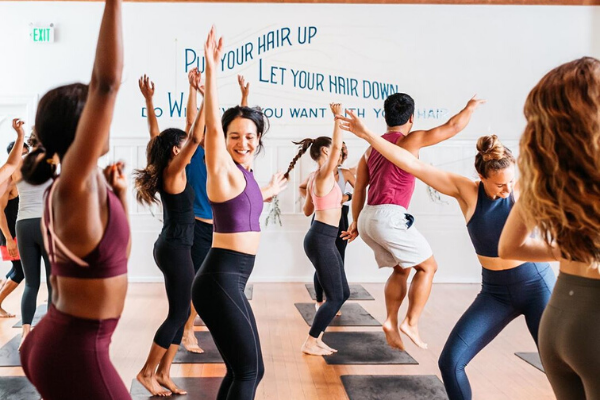A sign of the times, every fitness-related headline reads like this: The Fitness Industry Moves Online.
And it’s true. With nowhere else to go, fitness providers are searching for digital tools to help them reach exercisers and monetize their efforts. Likewise, as social distancing dictates, fitness-seekers have turned to streaming video, on-demand content, and at-home equipment.
These developments led us to ask: Will the fitness industry ever be the same?
In response, emails, texts, tweets, and LinkedIn comments poured in. As you might expect, the feedback fell into one of two camps: at-home versus in-person.
- In-person: “I love the community, environment, and workout. I can’t wait to go back.”
- At-home: “This app/piece of equipment is a game-changer. I’m never going back.”
A tale of two extremes. Innovation breeds opportunity at the expense of the status quo. In any industry, disruption divides people based on who’s missing out on or seizing an opportunity.
Among the disruptors, the rate and severity of change are often exaggerated. Conversely, the disrupted are slow or unwilling to respond — like in the early days when Flywheel and SoulCycle both passed on Peloton’s overtures (22:26 mark here). Often, reality tends to be more nuanced, especially in the near-term.
The big picture: Like most things, the future of fitness isn’t black or white, it’s grey. This is why, when the stay-at-home order is lifted, there will be a return to exercising in-person. Let’s call it “the bull case for boutique fitness”.
The Naysayers
It takes 14–21 days to form a new habit. If that’s true, the work-out-from-home crowd could easily establish a new fitness routine during the weeks- or months-long shutdown.
After the all-clear, factors like convenience, the perceived risk of returning to public spaces, and the thousands of dollars invested in new equipment make staying home an easy choice.
Besides, there’s nothing like surviving a pandemic to make you reevaluate your priorities. Suddenly, devoting two-plus hours to the gym (when you factor in the commute, parking, shower, etc.) pales in comparison to spending a few more minutes with the fam.
The Optimists
The shift to digital and at-home wasn’t a choice, they say — it was a mandate. On the other side of this crisis, people will crave the escapism, energy, and community of exercising together.
The bull case goes on to say that accountability, motivation, and real-time instruction—hallmarks of one-on-one or group training—are difficult to replicate virtually. Worse, isolation is fueling loneliness, posing a threat to mental health and overall well-being.
And don’t forget that at-home fitness isn’t a new phenomenon. Some people don’t have the spare space or cash. Others simply don’t have the desire or willpower to go it alone.
The Case for Community
In advocating for Barry’s, Y7 Studio, CrossFit, or sweating together in general, the conversation centers on community. The visceral, borderline-irrational appeal is difficult to quantify or articulate. Which makes trying all the more worthwhile.
Reading the science, working out with other people has benefits over working out alone. But results aren’t the only motivator. A 2014 Nielsen and Les Mills survey on global fitness trends found 63% of boutique studio-goers were there for the community element.
A deeper take: The rise of boutique fitness coincides with the decline of organized religion, especially among millennials.
In the US between 2013 and 2017, memberships to boutique studios grew 121% as the broader fitness industry boomed to $32B in value. Driving this trend, millennials have shown a preference for specialization and experience, attending studios at a higher rate than other demographics.
Over a similar period, millennials have moved further away from organized religion than ever before. According to a 2017 Pew poll, when asked about their religious affiliation, 29% of millennials identify as “spiritual, but not religious”, with 37% of all Americans reporting as religiously unaffiliated (atheist, agnostic, or “nothing in particular”).
Fitness as a Religion
This sentiment is best represented in How We Gather, a 2015 study authored by Angie Thurston and Casper ter Kuile of Harvard Divinity School.
While researching religious identity in a secular age, Thurston and ter Kuile stumbled upon an interesting development: millennials were turning to fitness classes for meaning, ritual, and community.
“People come because they want to lose weight or gain muscle strength, but they stay for the community… It’s really the relationships that keep them coming back.” – Casper ter Kuile
More specifically, the study revealed how fitness concepts like SoulCycle and CrossFit are playing the part of organized religion by offering the same tenets: community, personal transformation, social transformation, purpose-finding, creativity, and accountability.
Ultimately, the researchers concluded, religion isn’t dying. It’s changing. And now, the same can be said of boutique fitness and exercising in-person.
Looking Ahead
During life under lockdown, expect streaming and on-demand content to dominate the conversation. Likewise, connected fitness will ride this wave of momentum. Still, time will tell if this surge of sign-ups correlates to long-term adherence or extends beyond the already fit.
Meanwhile, fitness providers, including instructors, trainers, and owners, would be well-served by studying the How We Gather report, including this interview with CrossFit CEO Greg Glassman. Unbeknownst to them, the authors created a playbook of sorts for how to best serve members in an increasingly digital world.
A short-term fix, Zoom workouts and IG Live may be the sole source of revenue. But in the long run, video could end up being a trap. Instead of trying to compete with the Pelotons of the world on content or scale, double down where they come up short — empathy, personalization, and human interaction.
Remember: change was inevitable long before COVID-19. As we wrote in The Shifting Fitness Landscape, the trend toward tech-enabled exercise doesn’t eliminate sweating in real life. But it does mark the end of business as usual.
📉 By The Numbers
Over the past two weeks, ClassPass’s global revenue fell by 96%.
To their credit, ClassPass was quick to stop charging customers. They quickly resurrected their streaming workout feature. And they’ve also been proactive in advocating for the fitness industry.
But the fallout has broad implications. Long before COVID-19, there were concerns about ClassPass’s viability and impact on the industry. Now, expect those questions to be amplified.
What to watch for
- Studios already struggling to justify the ClassPass-as-middleman model could cut ties with the platform upon reopening.
- Inevitably, a portion of ClassPass’s studio partners will be unable to reopen.
- As members return to exercising in-person, they may feel compelled to support their favorite studios directly or reduce their spending, leading them to cancel their ClassPass membership.
- Individuals who invested in at-home or on-demand options could also cancel their membership.
Zooming out: While the numbers from other industry leaders like MINDBODY aren’t publicly available, you can extrapolate the impact from ClassPass’s data. If studios balk at paying their monthly subscriptions and transactional revenue dries up, software providers across the fitness space will confront a growing list of challenges.
🚲 Rethinking Hardware
Last week, Zwift laid off a number of senior employees.
What’s happening: Unrelated to coronavirus, the company is said to be undergoing a significant reorganization to focus on its core business and develop new hardware.
For context:
- Zwift is a virtual platform for running and cycling.
- To date, the company has raised $170M.
- Unlike Peloton, Zwift doesn’t sell at-home equipment.
Why it matters: In our previous coverage of Zwift, we noted the company’s intentions: to become a virtual platform, esports contender, and even an Olympic sport — not a hardware provider. Now, those ambitions appear to have evolved.
Looking ahead: Will Zwift introduce an indoor cycling trainer, like Wahoo Fitness, or a full-fledged bike like Peloton or SoulCycle? Or is there an acquisition on the horizon that helps them accelerate into the hardware space? Stay tuned to see how things play out.
📰 News & Notes
- Running from coronavirus.
- A $12,500 home exercise bike.
- Life Time plans to furlough 36,000 employees.
- India’s influence on wellness (and tech culture).
- The “Peloton wife” talks a little shit to short sellers.
- Be on the lookout for a new connected fitness company launching this spring.






